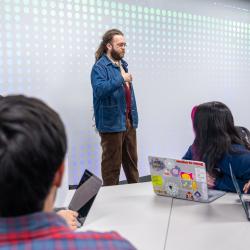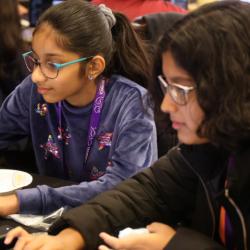Computer Science’s Ben Shneiderman Named Fellow of the National Academy of Inventors
Ben Shneiderman, Distinguished University Professor in Computer Science at the University of Maryland, has been named a fellow of the National Academy of Inventors (NAI).
This honor is awarded to academic inventors who have demonstrated a prolific spirit of innovation in creating or facilitating outstanding inventions that have made a tangible impact on quality of life, economic development and the welfare of society.
Shneiderman, who also has an appointment in the university’s Institute for Advanced Computer Studies, has submitted over 25 disclosures to UMD’s Office of Technology Commercialization in the fields of human-computer interaction and information visualization. Predominantly through copyright licensing, the university has licensed over 20 of his disclosures, generating almost $600,000.
UMD licensed one of Shneiderman’s recent inventions, Eventflow, to a Fortune 100 software company. Two-dozen companies licensed his most well-known invention, the treemap—a method of visually displaying complex sets of data using rectangular shapes—prior to engaging an exclusive distribution agreement.
Much of Shneiderman’s research has focused on finding the most efficient and user-friendly strategies for humans to use computers, particularly in making them more visually and graphically appealing. In the 1980s, Shneiderman pioneered highlighted text links, which have contributed to the success of the Web, and small touchscreen keyboards that are now on every smartphone. His move into information visualization spawned Spotfire, a company known for pharmaceutical drug discovery and genomic data analysis that was acquired in 2007 for $195 million. Shneiderman’s works have been cited over 400 times in others’ patents and applications.
“I owe my success to the supportive research community of the Human-Computer Interaction Lab, the great students I’ve worked with and my long-term collaboration with senior research scientist Catherine Plaisant,” said Shneiderman.
Shneiderman describes his research strategy of combining applied and basic research in a book that will be published in February 2016 titled “The New ABCs of Research: Achieving Breakthrough Collaborations”.
A member of the National Academy of Engineering and fellow of the IEEE, American Association for the Advancement of Science, and Association for Computing Machinery (ACM), Shneiderman was founding director of the university’s Human-Computer Interaction Laboratory (HCIL) from 1983-2000. Since his arrival at UMD in 1976, he has received numerous awards, including the ACM SIGCHI Lifetime Achievement Award, IEEE Career Visualization Award, National Federation of Advanced Information Services Miles Conrad Lecture Award and ACM SIGCAS’s Making A Difference Award.
The 168 new fellows bring the total number to 582, representing more than 190 research universities and governmental and nonprofit research institutions. The fellows will be inducted on April 15, 2016, as part of the Fifth Annual Conference of the National Academy of Inventors at the United States Patent and Trademark Office in Alexandria, Va.
Media Relations Contact: Abby Robinson, 301-405-5845, abbyr@umd.edu
University of Maryland
College of Computer, Mathematical, and Natural Sciences
2300 Symons Hall
College Park, MD 20742
www.cmns.umd.edu
@UMDscience
About the College of Computer, Mathematical, and Natural Sciences
The College of Computer, Mathematical, and Natural Sciences at the University of Maryland educates more than 7,000 future scientific leaders in its undergraduate and graduate programs each year. The college's 10 departments and more than a dozen interdisciplinary research centers foster scientific discovery with annual sponsored research funding exceeding $150 million.







